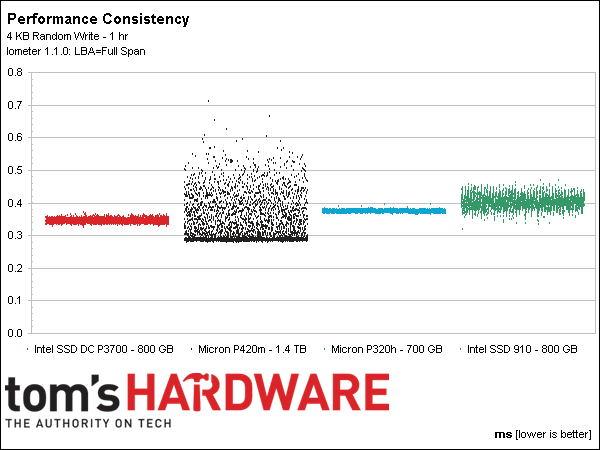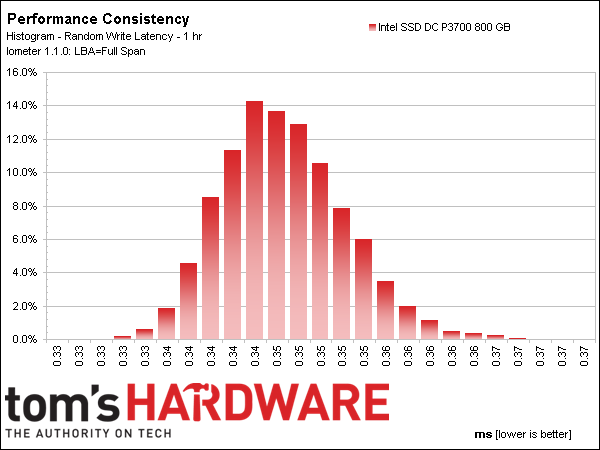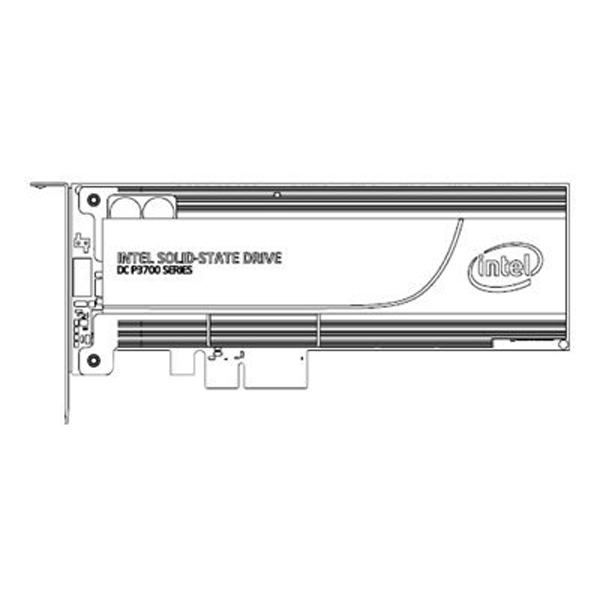Intel SSD DC P3700 800GB and 1.6TB Review: The Future of Storage
With the introduction of its SSD DC P3700, P3600, and P3500, Intel is giving us our first taste of the PCIe-based NVMe specification. We take the flagship P3700 for a drive in its 800 GB and 1.6 TB incarnations. Just how fast is the future of storage?
Results: Performance Consistency
In the following tests, we subject our enterprise-oriented SSDs to 25 hours of continuous random 4 KB writes. We record the IOPS every second, giving us 90,000 data points. We then zoom in on the last 60 minutes to better visualize the results.
The 800 GB SSD DC P3700 puts up impressive numbers during our performance consistency testing. While it's true that Micron's P420m achieves lower response times across a majority of its writes, outliers are enough to pull down the overall performance.
You might be wondering how Intel's new drive posts such low response times, since we just showed you that it's slower than the competition from Micron. Our tests are performed at a conservative queue depth of 32, where the 800 GB SSD DC P3700 holds its own (even though it's less expensive and lower-capacity).
We did receive the 1.6 TB SSD DC P3700 late in our testing process, so we only have data from the 800 GB for this metric. Regardless, though, consistency is excellent, and the smaller model easily beats the P420m and SSD 910. It simply cannot match the tight grouping posted by Micron's P320h, which benefits from expensive, low-latency, SLC NAND.
We also wanted to look at how consistency changed across queue depths. And as you can see, there is very little change as we shift from a command depth of four to 32 to 256. It's particularly impressive that the SSD DC P3700 fares so well at low queue depth settings. You can expect it to behave equally well in server or workstation environments.
As mentioned, the SSD DC P3700 is supported by a native driver in Windows Server 2012 R2 and proprietary software from Intel. We wanted to test for performance differences between the two.
Although the resulting patterns appear quite distinct, standard deviation and overall consistency remained almost identical. We didn't run every one of our tests with both drivers, but instead chose to focus on some of the more strenuous. In a couple of pages, we'll regale you with more comparative data.
Get Tom's Hardware's best news and in-depth reviews, straight to your inbox.
We normally don't include out-of-box performance in our charts because enterprise-oriented hardware spends most of its time in a steady state. But I just had to plot this data. Right out of the box, Intel's SSD DC P3700 hit more than 400,000 write IOPS for almost 10 minutes, and didn't settle into steady-state for another two hours. In fact, the drive aggressively fought our efforts to keep it in steady state. Pausing for as little as a few seconds was all it took to push performance back into the 300,000 IOPS-range for short bursts.
Finally, we charted the distribution of response times at steady-state. The SSD DC P3700 gives us a beautiful bell curve without any outliers. This is the sort of consistency we have come to expect from Intel, and the SSD DC P3700 delivers.
Current page: Results: Performance Consistency
Prev Page Results: 4 KB Random Performance and Latency Next Page Results: Sequential Performance-
xback In the 1st table on page 1, the "4k random write IOPS" are reversed :)Reply
(3500 scores highest, while the 3700 scores lowest) -
redgarl OCZ already went there and even made their own connector for providing more bandwith to SSD... just a shame that now Intel try to remove the carpet from beneath the feet of OCZ. Well, old tech is new tech.Reply
By the way, OCZ revodrive was priced similarly, I don't see that big fuzz from Toms here. -
Nuckles_56 "Intel's 2 TB model purportedly needs 650 LFM across the drive"Reply
What the hell is LFM? -
JeanLuc The active power consumption numbers on first table are wrong (I hope!) 35,000 watts active?Reply
Edit:
It's not actually wrong it might just be my out of date browser I'm using in the office but for me the numbers aren't lining up correctly. -
pjmelect Reply"Intel's 2 TB model purportedly needs 650 LFM across the drive"
What the hell is LFM?
Linear Feet per Minute of airflow
-
pjmelect Reply"Intel's 2 TB model purportedly needs 650 LFM across the drive"
What the hell is LFM?
Linear Feet per Minute of airflow
-
Nuckles_56 Reply13947314 said:"Intel's 2 TB model purportedly needs 650 LFM across the drive"
What the hell is LFM?
Linear Feet per Minute of airflow
Ah that makes sense now





